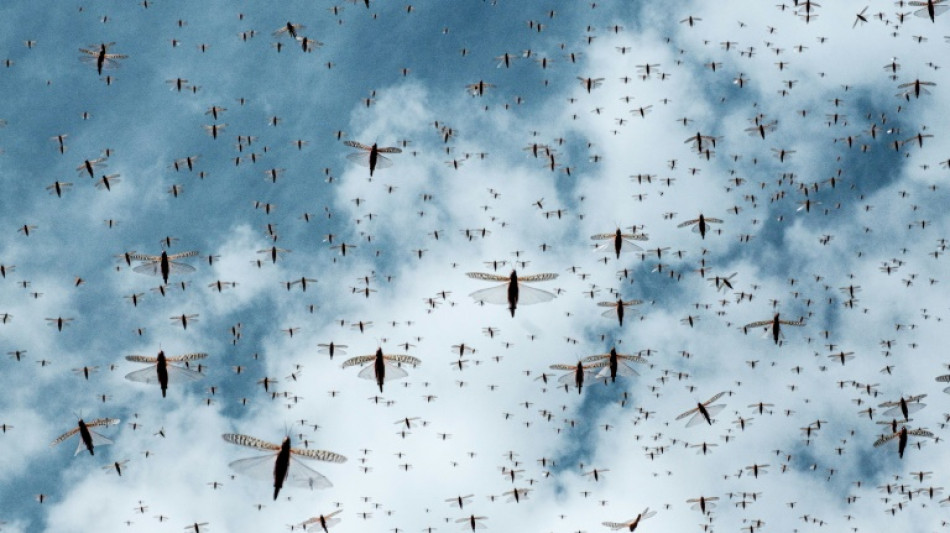
-
 'AI president': Trump deepfakes glorify himself, trash rivals
'AI president': Trump deepfakes glorify himself, trash rivals
-
Belgium probes drone sightings after flights halted overnight

-
 Five things to know about 'forest COP' host city Belem
Five things to know about 'forest COP' host city Belem
-
World leaders to rally climate fight ahead of Amazon summit

-
 Engine fell off US cargo plane before deadly crash: officials
Engine fell off US cargo plane before deadly crash: officials
-
Mexican leader calls for tougher sexual harassment laws after attack

-
 Meghan Markle set for big screen return: reports
Meghan Markle set for big screen return: reports
-
Japan deploys troops after wave of deadly bear attacks

-
 FIFA announce new peace prize to be awarded at World Cup draw in Washington
FIFA announce new peace prize to be awarded at World Cup draw in Washington
-
Australia's Cummins hints at return for second Ashes Test

-
 Boeing settles with one plaintiff in 737 MAX crash trial
Boeing settles with one plaintiff in 737 MAX crash trial
-
Man City win as Inter stay perfect, Barca held in Champions League

-
 French superstar DJ Snake wants new album to 'build bridges'
French superstar DJ Snake wants new album to 'build bridges'
-
Barca rescue draw at Club Brugge in six-goal thriller

-
 Foden hits top form as Man City thrash Dortmund
Foden hits top form as Man City thrash Dortmund
-
NBA officials brief Congress committee over gambling probe

-
 Inter beat Kairat Almaty to maintain Champions League perfection
Inter beat Kairat Almaty to maintain Champions League perfection
-
Newcastle sink Bilbao to extend Champions League winning run

-
 Wall Street stocks rebound after positive jobs data
Wall Street stocks rebound after positive jobs data
-
LPGA, European tour partner with Saudis for new Vegas event

-
 Eyes turn to space to feed power-hungry data centers
Eyes turn to space to feed power-hungry data centers
-
Jazz lose Kessler for season with shoulder injury

-
 League scoring leader Messi among MLS Best XI squad
League scoring leader Messi among MLS Best XI squad
-
MLS bans Suarez for Miami's winner-take-all playoff match

-
 McIlroy appreciates PGA of America apology for Ryder Cup abuse
McIlroy appreciates PGA of America apology for Ryder Cup abuse
-
Garnacho equaliser saves Chelsea in Qarabag draw

-
 Promotions lift McDonald's sales in tricky consumer market
Promotions lift McDonald's sales in tricky consumer market
-
Five things to know about New York's new mayor

-
 Anisimova beats Swiatek to reach WTA Finals last four
Anisimova beats Swiatek to reach WTA Finals last four
-
US Supreme Court appears skeptical of Trump tariff legality

-
 AC Milan post third straight annual profit on day of San Siro purchase
AC Milan post third straight annual profit on day of San Siro purchase
-
Angelina Jolie visits Ukrainian frontline city, media reports say

-
 UN says forests should form key plank of COP30
UN says forests should form key plank of COP30
-
Star designer Rousteing quits fashion group Balmain

-
 Mexico's Sheinbaum steps up cartel fight after murder of anti-narco mayor
Mexico's Sheinbaum steps up cartel fight after murder of anti-narco mayor
-
Attack on funeral in Sudan's Kordofan region kills 40: UN

-
 Key PSG trio set for spell on sidelines
Key PSG trio set for spell on sidelines
-
Democrats punch back in US elections - and see hope for 2026

-
 BMW reports rising profitability, shares jump
BMW reports rising profitability, shares jump
-
US Supreme Court debates legality of Trump's tariffs

-
 Bolivia Supreme Court orders release of jailed ex-president Jeanine Anez
Bolivia Supreme Court orders release of jailed ex-president Jeanine Anez
-
Wall Street stocks rise after positive jobs data

-
 'Hostage diplomacy': longstanding Iran tactic presenting dilemma for West
'Hostage diplomacy': longstanding Iran tactic presenting dilemma for West
-
Rybakina stays perfect at WTA Finals with win over alternate Alexandrova

-
 Le Garrec welcomes Dupont help in training for Springboks showdown
Le Garrec welcomes Dupont help in training for Springboks showdown
-
Brussels wants high-speed rail linking EU capitals by 2040

-
 Swiss business chiefs met Trump on tariffs: Bern
Swiss business chiefs met Trump on tariffs: Bern
-
At least 9 dead after cargo plane crashes near Louisville airport

-
 France moves to suspend Shein website as first store opens in Paris
France moves to suspend Shein website as first store opens in Paris
-
Spain's exiled king recounts history, scandals in wistful memoir


Scientists find chemical that stops locust cannibalism
Plagues of locusts that darken the skies and devastate all things that grow have been recorded since Biblical times, and today threaten the food security of millions of people across Asia and Africa.
But a new finding reported Thursday -- of a pheromone emitted by the insects to avoid being cannibalized when in a swarm -- could potentially pave the way to reining in the voracious pests.
Study leader Bill Hansson, director of the Max Planck Institute's Department of Evolutionary Neuroethology, told AFP that the new paper, published in Science, built on prior research that found swarms are directed not by cooperation -- but actually the threat of consumption by other locusts.
While repulsive to modern humans, cannibalism is rife in nature -- from lions that kill and devour cubs that are not theirs, to foxes that consume dead kin for energy.
For locusts, cannibalism is thought to serve an important ecological purpose.
Migratory locusts (Locusta migratoria) occur in different forms and behave so differently that they were, until recently, thought to be entirely different species.
Most of the time, they exist in a "solitary" phase keeping to themselves and eating comparatively little, like timid grasshoppers.
But when their population density increases due to rainfall and temporarily good breeding conditions, which is followed by food scarcity, they undergo major behavioral changes due to a rush of hormones that rev them up, causing them to aggregate in swarms and become more aggressive.
This is known as the "gregarious" phase and it's thought the fear of cannibalism helps keep the swarm moving in the same direction, from an area of lower to higher food concentration, according to 2020 research by Iain Couzin of the Max Planck Institute for Animal Research.
Hansson explained that "locusts eat each other from behind."
"So if you stop moving, you get eaten by the other, and that got us thinking that almost every animal who is under threat has some kind of countermeasure."
In painstaking experiments that took four years to complete, Hansson's team first established that cannibalism rates did indeed increase as the number of "gregarious" locusts kept in a cage went up, proving in the lab what Couzin had observed in the field in Africa (the triggering point was around 50 in a cage).
Next, they compared the odors emitted by solitary and gregarious locusts, finding 17 smells produced exclusively during the gregarious phase.
Of these, one chemical, known as phenylacetonitrile (PAN), was found to repel other locusts in behavioral tests.
PAN is involved in the synthesis of a potent toxin sometimes produced by gregarious locusts -- hydrogen cyanide -- so emitting PAN appeared to fit as the signal to tell others to back off.
- Genome editing -
To confirm the finding, they used CRISPR editing to genetically modify locusts so they could no longer produce PAN, which in turn made them more vulnerable to cannibalism.
For further confirmation, they tested dozens of the locusts' olfactory receptors, eventually landing on one that was very sensitive to PAN.
When they gene edited locusts to no longer produce this receptor, the modified locusts became more cannibalistic.
Writing in a related commentary in Science, researchers Iain Couzin and Einat Couzin-Fuchs said the discovery helped shed light on the "intricate balance" between the mechanisms that cause migratory locusts to group together versus compete with one another.
Future methods of locust control could therefore use technology that tips that delicate balance towards more competition, but Hansson cautioned: "You don't want to eradicate the species."
"If we could diminish the size of the swarms, steer them to areas where we are not growing our crops, then a lot could be gained," he added.
P.AbuBaker--SF-PST



